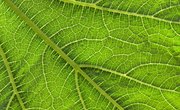
Plants play a vital role in the cycle of life on Earth, creating both the oxygen and food that many species need to survive. Plant species create simple sugars, such as glucose and fructose, and starches that they use in different ways depending on their needs. To do this, they use the chlorophyll in their leaves or leaf equivalents to convert water, sunlight and carbon dioxide into a simple sugar, which the plant uses immediately or stores for later use. Plant life’s two distinct strategies for storing excess sugar act as food production for other creatures – like humans.
TL;DR (Too Long; Didn't Read)
Plants create simple sugar through photosynthesis. They turn the simple sugars into starches for use in their roots and seeds, while simple sugars, such as fructose and glucose, appear in the stalks and fruits of plants.
Food Creation and Movement
Plants contain a system for the movement of water and a system for the movement of energy called the xylem and the phloem, respectively. For photosynthesis to occur, a plant must move water to its leaves through the xylem, a series of small, branching tubes that move water from the roots to the leaves. After a plant uses the building blocks of photosynthesis to make its food, it uses its phloem to move the glucose created to its branches, roots, trunk and fruits.
Simple Sugars: Readily Available
Photosynthesis creates glucose, which acts as the base of other more complex sugars found in plants. For example, fructose, or fruit sugar, shares a structure similar to glucose, but it is used in different parts of the plant. As simple sugars are water soluble, plants can access and use them easily. Glucose appears in the stems of some plants, like the corn plant, while fructose, as its name implies, appears commonly in fruit. Humans and other animals often eat these foods to gain these basic units of chemical energy.
Starches: Long-Term Storage
Starch acts as a form of reserve energy in plants. Plants contain two types of starch – amylose and amylopectin – both polysaccharides or combinations of sugar molecules. In some cases, it takes thousands of sugar molecules to form a starch. Roots, legumes and seeds commonly contain starches, the latter case because starch feeds the embryonic stage of a plant. Animals use their digestive enzymes to break down starches into simple sugars for use. Foods like potatoes contain high levels of the sugar chains. Other polysaccharides, like cellulose, give plants structure, providing walls for their cells.
Why Use Sugars?
Compared to sugars, lipids and fats have a relatively high nutritional density. However, plants tend to favor sugars as an energy source, although lipids can be found in the seeds of some species. Some scientists hope to increase the concentration of lipids in plants both as a food and fuel source. The reason plants don't use lipids as energy, some researchers believe, is because plants have evolved specifically to use sugars for so long.
References
- University of California Riverside: Nature of Plant Substances
- University of Miami: The Molecules That Make Plant Cells ... Different
- Encyclopedia Britannica: Starch
- United States Department of Agriculture: Commentary: Why Don't Plant Leaves Get Fat
- The Royal Society of Chemistry: Carbohydrates
- Smithsonian Science Education Center: What Is Photosynthesis
- Georgia State University: Plant Energy Transport
- University of California Davis: Photosynthesis & Respiration
About the Author
Doug Johnson is an Edmonton-based writer, editor and journalist.
